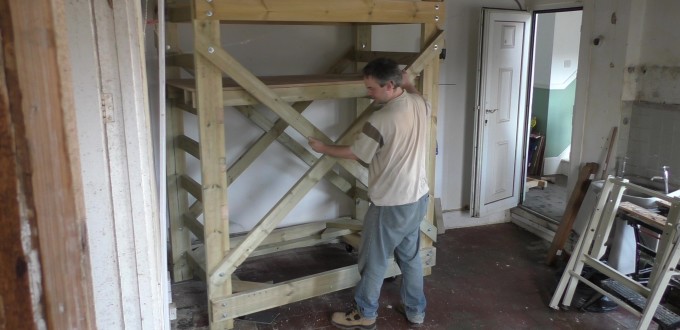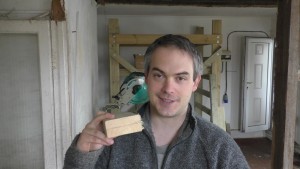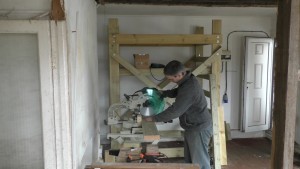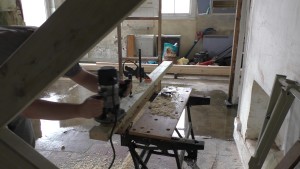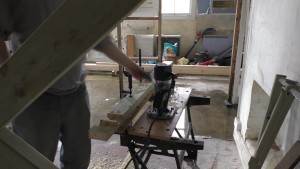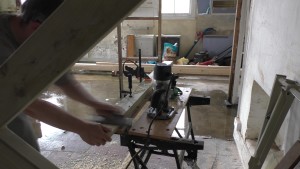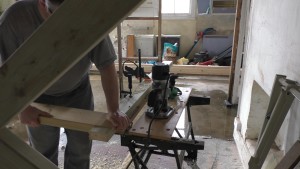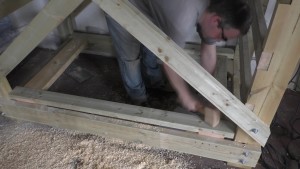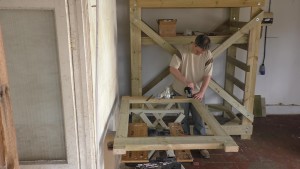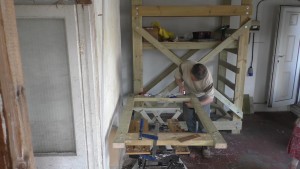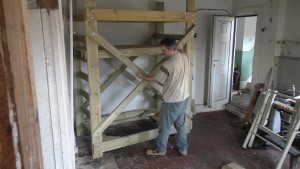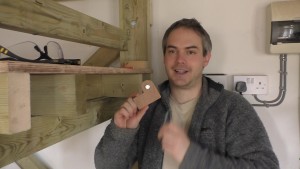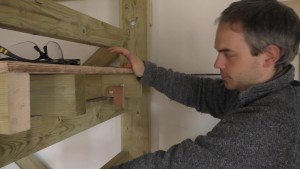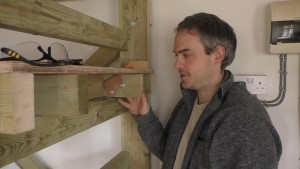In part six of this series on building a homemade scaffolding tower I built the platform and had a test climb of the tower. In this part I build and install the dolly system to move the tower and fit clips to the end of the platform.
As I perhaps slightly over built my scaffolding tower I found that it was a bit a lot too heavy to move by just dragging around so I needed some sort of dolly system to move it. The solution I came up with was simple and incredibly effective.
There were a few constraints that I had to work with for the dolly frame. The wheels couldn’t mount to the bottom of the legs as the scaffold couldn’t be any taller and fit in my work area. The wheels would have to be retractable in some way as I wasn’t happy with the idea of the scaffold sitting on the wheels while I climbed the tower. Finally, the wheels would have to be inside the area described by the legs so that the scaffold could be pushed right up against a wall.
Earlier on in the build I’d fitted corner braces to stop the tower twisting and it occurred to me that, like everything else, these braces were very sturdily built and that gave me an idea. I decided to build a dolly frame that would fit inside the tower and which could lift it up by the corner braces.
The first thing I needed to do was cut my dolly frame timber to length and then join it together. By necessity the joints would be right where the castor wheels would be so they needed to be strong and I settled on half lap joints. For speed reasons I decided to trench cut each end of the joint on the mitre saw first.
The short edges were made from 50×150 mm offcuts that I had left over from the legs. The long edges were made from 50×100 mm rung left overs. The mortice in the long edges had to be inset from the end by about 50mm in order for the castor to line up correctly with the centre of the beam and still be able to rotate within the scaffolding tower.
Once the trench cuts were complete and the mortices defined I cleaned up the rest of the mortice with the router.
The 150mm trench that was needed was winder than my router could span so I left a small section in the middle which I later took out with a mallet.
I then quickly cleaned up the joint with a bit of sandpaper.
A test fit showed that it was a very nicely fitting joint.
Once all the joints were cut I did a quick test fit of the dolly frame. Rather than put it under the supports which would be awkward I put it together on top of them.
With everything fitting nicely I took the dolly frame out, put it back together and laid out for the castors.
After a lot of drilling and counterboring I bolted on the casters. The tops of the bolts holding the castors have to be sunk beneath the top of the dolly frame as this is the face that pushes up on the corner bracing to lift the scaffold.
Fitting the dolly frame to the scaffold was a fairly simple affair although I have no photos of it as I was concentrating on not screwing up. Basically I just tipped the scaffold over slightly on it’s long edge and slid the dolly frame under. I lifted the legs about 120mm and there was no danger of the scaffold falling over so it greatly reassured me that it also wouldn’t fall over in use.
With the dolly frame in place I couldn’t resist having a little play moving the scaffold around. Notice in this photo that there are pieces of wood between the top of the dolly frame and the corner braces. That is how the dolly supports the scaffold while it’s being moved.
The scaffold was quite easy to move although the small wheels did have a bit of a tendency to get caught in holes in the floor (there weren’t many holes though). The only mobility issue I had now was how to get the chocks in when putting the scaffold on the dolly. For the test move I lifted one end of the scaffold while the wife inserted the chocks. Clearly that wasn’t a long term solution as the scaffold weighed too much to be lifting it up all the time.
While I had a think about how to lift the scaffold I turned my attention back to securing the platform. The test climb showed that I really needed to fit something to stop the platform from moving. While it probably wouldn’t fall down in a hundred years the consequences of it happening were sufficiently bad that I wanted to do something about it.
As with the dolly frame I was really pleased with the solution I came up with. Initially I’d planned on fitting a strip of wood along the bottom of the platform. This would certainly have worked but if I wanted to move the platform it would need to be taken off. The other idea I had was to cut notches in the bottom of the platform. Again this would work but it felt a bit stupid to be building something for strength only to then cut chunks out of it.
In the end I settled on a simple little catch system made from a scrap of 18mm ply and a couple of bolts. The catch is nothing more than a P shaped piece of wood cut out with a jigsaw. At the focus point of the circular part of the P I drilled a hole for a bolt.
I offered the piece up to the bottom of the platform and aligned it such that when the catch was down it caught on the rung of the scaffold but it was still able to rotate up and free the platform to move. I then drilled a hold in the platform for the catch, this is the lower of the two holes in the photo.
Next, with the catch in place and in the locked position I drilled another hole above it, the top hole in the photo. Through this hole I slid a bolt which locks the clip in the down or locked position.
The clever thing about this clip is that the more the platform tries to slide out the tighter the clip locks. When it comes time to move the scaffold simply knock out the top pin and lift the clip. Since the clip would naturally fall down on it’s own and relock (default safe) I also designed it so that the locking pin can lock the clip open.
I debated how many clips I should fit. Two, one each end, would be enough so I fitted four.
The scaffold is getting very close to completion now. There is only the guard rail to fit and the lifting problem left to sort out which I will do in the next part.
